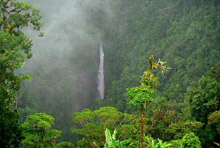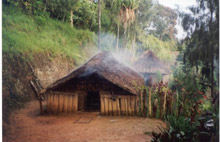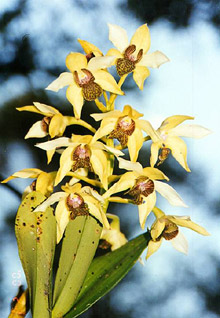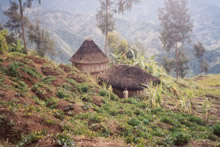Papua New Guinea's
beauty, danger
http://www.latimes.com/travel/la-tr-png1aug01.story
-Tribal culture and colorful tradition
mix with some tense moments on the southwest
Pacific island.
 By Mary Altier, Special to The Times
By Mary Altier, Special to The Times
Men painted like skeletons with white paint
and charcoal terrorized the crowd with primitive
bows and arrows. Mudmen wearing huge heads
crafted from dried mud shook weapon-like
6-inch fingernails menacingly.
Forty years ago, visitors had a lot to
fear from Papua New Guinea's indigenous
groups, who were accustomed to killing and
eating one another. These days, though,
they have left their age-old rivalries and
cannibalistic practices in the past, instead
celebrating their disparate cultures. At
the annual Mt. Hagen Cultural Festival and
Sing-Sing, representatives of the country's
myriad tribal groups gather to sing, dance
and laugh together, keeping alive their
traditions on this remote enigmatic island
in the southwest Pacific.
--------------------------------------------------------------------------------
FOR THE RECORD: Papua New
Guinea —An article in Sunday's Travel
section about Papua New Guinea said that
New Guinea was the world's second-largest
island after Australia. Australia is a continent.
New Guinea ranks second after the island
of Greenland.
--------------------------------------------------------------------------------
Papua New Guinea takes up the eastern half
of New Guinea island, the world's second-largest
after Australia, its geologic cousin about
100 miles to the south. Irian Jaya, which
belongs to Indonesia, occupies its western
side.
Many visitors travel here for the superb
diving and snorkeling, but I came here two
years ago to delve into tribal cultures
that had intrigued me since a visit to the
Indonesian island of Sulawesi nearly two
decades ago. Mt. Hagen's August festival
gave me an ideal excuse to visit and hopscotch
by plane to see the nation's other natural
and cultural attractions.
Getting to and traveling in Papua New Guinea
is not easy. Outside its capital of Port
Moresby, the country has limited tourist
facilities and infrastructure, and hotels
book up fast during festivals. For convenience,
my husband, John, and I booked an unescorted
10-day group tour with 15 other travelers
through Trans Niugini Tours, which arranged
our transportation, hotels and meals.
Crime was another worry, and we thought
we'd find safety in numbers. The State Department,
which warns travelers of violent crime against
tourists in Port Moresby and in Mt. Hagen,
advises against taking public taxis and
buses in mostareas of the country and recommends
traveling with a group. It was valuable
advice: A couple of times, the tour company
got us out of potentially dangerous situations.
 Three
colonial powers Three
colonial powers
We landed in Port Moresby on Papua New
Guinea's southern shore and the next morning
flew to Mt. Hagen, a Highlands city with
a frontier feel. Today, the Highlands is
the most agriculturally productive and densely
populated area in the country, but it was
not until the 1930s that the Western world
discovered that the region was inhabited.
Through the centuries, three colonial powers
squabbled over New Guinea. By the mid-1800s,
the Netherlands controlled the western half
of New Guinea, now Irian Jaya, and Britain
and Germany divided up the east.
At the beginning of World War I, Australia
wrested control of the German part of Papua
New Guinea, and six years later, the League
of Nations granted it sovereignty over the
eastern part. In 1975, Australia gave Papua
New Guinea its independence.
Australians first ventured into the Highlands
for gold, finding instead verdant valleys
sliced by rivers and streams and mountain
peaks such as the 14,880-foot Mt. Wilhelm.
Here, as they had for thousands of years,
women tilled the fertile soil by hand, planting
sweet potatoes and greens; warriors painted
in fierce colors and markings protected
them.
But life is not so bucolic in Mt. Hagen,
an unattractive, sometimes unruly town.
We settled into the simple, motel-like Kimininga
Lodge, which was less than a mile from the
Sing-Sing, the celebratory dance and festival
that would begin the next day.
Early Saturday morning, we found only a
few performers when we arrived at the muddy
festival grounds. Soon, people hauling cardboard
boxes filled with cowrie shells and tropical
bird feathers came trudging slowly across
the rain-soaked field. We watched as they
painted their faces and bodies in bright
pigments and adorned themselves with large
shells and plumage in primary colors.
Men peered into broken shards of mirror
as they transformed themselves. Wives straightened
their husbands' long tails made from the
feathers of the endangered bird of paradise.
Parents dressed and painted their children.
Then each troupe lined up under signs handwritten
with the names of their groups and waited.
Suddenly, the ground shook with the pounding
of bare feet and the rhythm of chanting
and hourglass-shaped kundu drums covered
with lizard or snakeskin. We watched as
the first group danced into the informal
arena.
They were followed by rows of armed warriors,
who swept across the field in a nearly impenetrable
line. They simulated battles they had fought
through the ages, though at the end of the
day, the fierce combatants put down their
spears to accept orange Popsicles handed
out by volunteers.
There was a palpable sensation of tribal
and clan loyalty. Even after the festival
ended, the dancing and singing continued
for several hours, the field vibrating with
chants and drums.
Over the course of two days, more than
30 troupes filed onto the field, representing
the country's four regional groups: Papuans
from the south, New Guineans from the north,
Highlanders from the mountains and Islanders
from its 600 smaller islands.
Papua New Guinea's 5 million people speak
about 715 indigenous languages. English
is spoken by less than 2% of the population,
and its lingua franca is Melanesian pidgin,
a 1,500-word trade language mainly derived
from English.
As we traveled around the country, John
and I had fun trying to decipher it. "Thank
you very much" is tenkyu tru and a
trivial matter is samting nating (something-nothing).
We saw a sign at Mt. Hagen's airport as
we waited for a charter flight to Amboin:
"Luk aut pawa masin ken kirap anitaim"
— "Caution generator starts automatically."
Downriver in a canoe
In less than an hour, a young Nepali pilot
flew us in a nine-passenger plane northwest
to a grassy airstrip at Amboin, an outpost
near the Sepik River, a tropical lowland
with villages little changed by modern development.
We stayed at Trans Niugini Tours' luxurious
Karawari Lodge, which had dramatic views
of the jungle and the Karawari River, a
tributary of the Sepik.
The lodge had an excellent selection of
handicrafts for sale, and I couldn't resist
a necklace made from a kina shell, a large
crescent-shaped, gold-hued shell that was
once the region's currency.
After lunch, with the sultry, humid air
clinging to us like a wet blanket, we went
downriver in a dugout canoe for the first
of many visits to riverfront communities.
At Yimas, I saw an amusing instance of
worlds colliding as local teacher and community
leader Lawrence Doming, wearing face paint
and little else but jewelry, chatted on
high-tech topics with my software engineer
husband, who wore a golf shirt and shorts.
They swapped business cards and shook hands.
The next morning, we again boarded canoes
to visit other riverside villages. At the
Amboin Primary School, students sang and
danced for us then presented us with handmade
garlands of jungle flowers. The 10-year-old
daughter of Chris, our guide, was one of
the performers.
At Kundamam, we watched locals prepare
sago, one of their staple foods. It was
a labor-intensive process that made me thankful
for grocery stores: First, they cut down
and split a sago palm tree, then took the
pulp from inside, washed it and pounded
it into a flour that they liquefied with
water. The batter is used to make porridge
and pancakes, which I found bland and starchy.
I preferred our packed lunch of curried
yam salad, fish and fruit.
Next, we visited Amangavi II, a village
where locals wearing traditional dress and
face paint welcomed us into their Spirit
House, a sacred place usually off-limits
to tourists. At Konmei village, we watched
artisans craft the kundu drums that we had
seen at the Mt. Hagen Sing-Sing.
After two nights at Karawari Lodge, we
were supposed to fly to Tari, a small Highlands
town that's little more than an airfield,
a few shops and a post office. From there,
we should have been bused to Ambua Lodge,
but a group of armed rascals angered by
local elections had taken over the airport
and hijacked Tari's one police car, so the
tour company flew us to Mendi, the capital
of the Southern Highlands, then helicoptered
us to Ambua Lodge. The short, unplanned
helicopter flight low over the rich green
Highland hills was one of the trip's highlights.
The segregated Huli
Ambua Lodge is Trans Niugini Tours' most
spectacular property, with round thatched-roof
cottages cascading down a steep hill. Here,
I had hoped to get a closer look at the
Huli Wigmen, who live in villages dotting
the rugged Highlands. And sure enough, stocky,
well-muscled Wigmen had trekked from their
remote settlements to perform for us at
the lodge.
They put their gear in the lodge's parking
lot, painstakingly painted their faces with
red and yellow ocher and adorned themselves
with feathers, fur, bands of snakeskin and
cassowary quills through their nasal septa.
With delicate red and yellow daisies, they
decorated the matted hair wigs that looked
like Napoleonic hats gone wild.
Huli life is segregated. In every village
is a women's hut — they tend the pigs,
the families' most important assets, which
sleep in the houses — and a men's
hut, where they live together and govern
the village. The Wigmen believe that female
contact diminishes their strength and male
status.
One young Wigman proudly told us that he
had gone to live in the men's house when
he was 6 years old and had not eaten food
cooked by women since then because the men
believed it was unclean.
Howard, a Wigman and our excellent guide,
did not seem to worry about being contaminated
by contact with women. He took us out before
dawn the next morning to try to spot the
highly endangered bird of paradise. Papua
New Guinea has more than 700 bird species,
and 38 of the world's 43 species of bird
of paradise are found here. The males proudly
wear the brilliant plumage. Look for long
iridescent tails, Howard told us, and with
his help, we spotted one a long distance
away.
When we returned to the lodge, lunch was
ready. As we dined on pork, cabbage, watercress
and sweet potatoes, all cooked by hot rocks
in an underground oven, or mumu, I kept
hearing soft animal noises. I asked the
waitress what it was. "Oh yes,"
she said. "We are playing our CD of
bat sounds."
Teeming coral reefs
The following day, we were bused over an
unpaved, rutted road to Tari to catch a
charter plane for Madang, a scenic coastal
town. But when we got to Tari, we found
an abandoned, looted and burned town and
no plane. With a machete-wielding Wigman
perched at the door of the van, our driver
kept circling the airport until the plane
arrived. Relieved to see it, we quickly
scrambled aboard.
Madang's best attraction is not tribal
arts, but the sea. The area, surrounded
by reefs and wrecks, is renowned among divers,
and we learned why as we snorkeled in its
clear turquoise waters. It teems with fish
and coral species. Hundreds of wrecks, many
of them from World War II, have been transformed
into coral reefs.
John went off to snorkel, and I visited
a small coastal village with a guide. During
an informal tour of the jungle, I learned
which plants the locals use for birth control,
pain and as an antidote to the bite of the
deadly black adder.
Chatting with the guide, I told him I had
attended the Mt. Hagen Cultural Festival
a few days earlier. His eyes lighted up.
He and his family had danced in the performance.
As we parted, I shook his hand and tried
out a pidgin phrase — Mi laikim
yu tru — "I like you very
much."
— Mary Altier
|